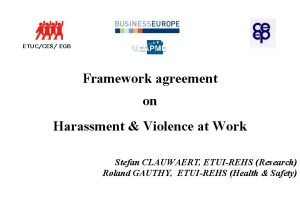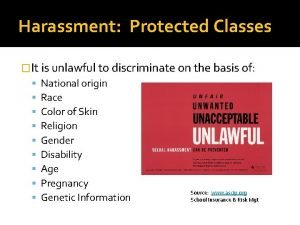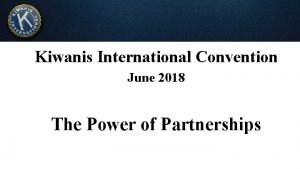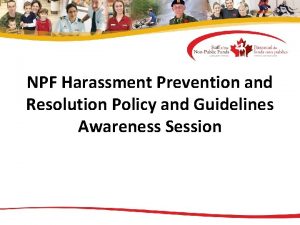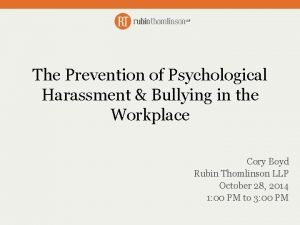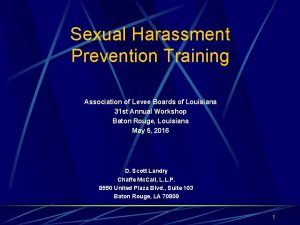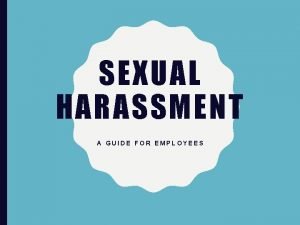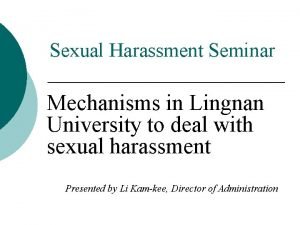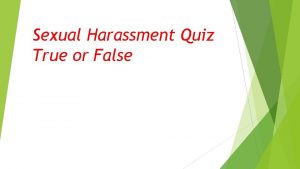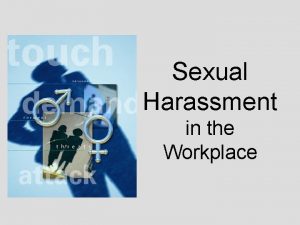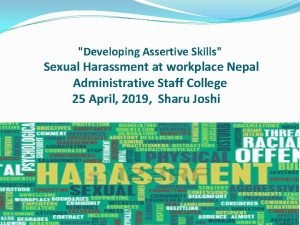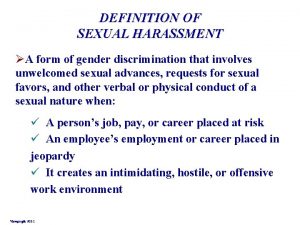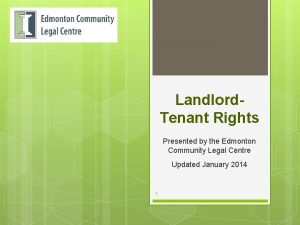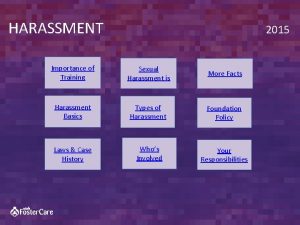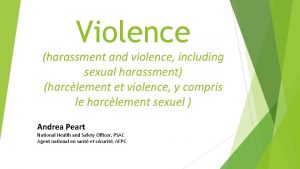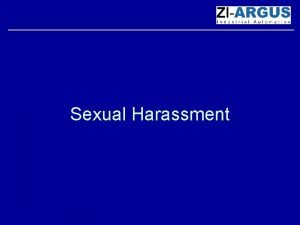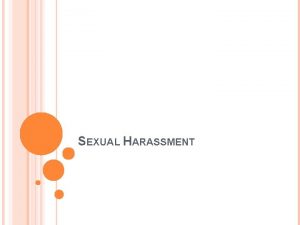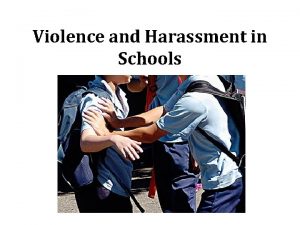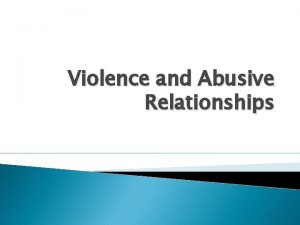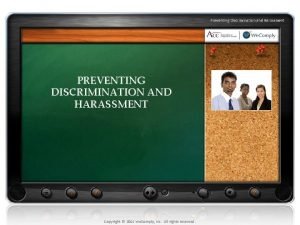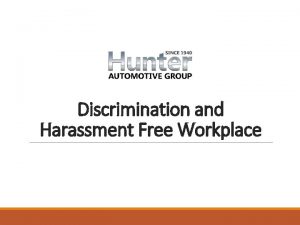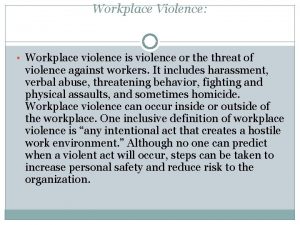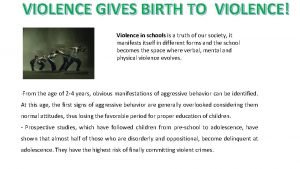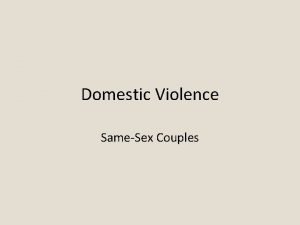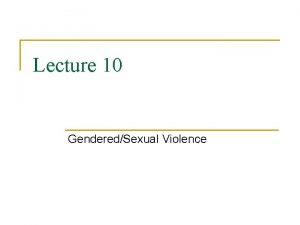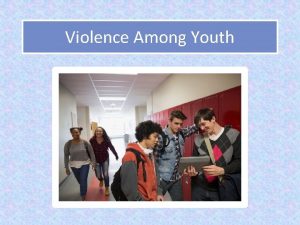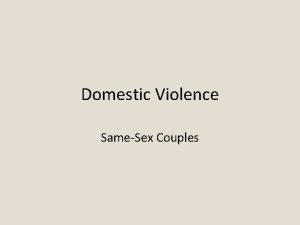Violence and Harassment Convention 2019 Challenges for South



















- Slides: 19

Violence and Harassment Convention 2019: Challenges for South Africa Karin Calitz Law Faculty Stellenbosch University

Scope of the Convention Wide scope of the Convention The Convention prohibits and addresses violence and harassment in one instrument The Convention is applicable to the “world of work” which is a much broader concept than the workplace and “worker” which is more widely defined than “employee”.

Definition of violence and harassment “A range of unacceptable behaviours and practices or threats thereof, whether a single occurrence or repeated, that aim at, result in, or are likely to result in physical, psychological, sexual or economic harm, and includes gender based violence and harassment” Gender based harassment is defined as violence and harassment directed at persons because of their sex or gender, or affecting persons of a particular sex or gender disproportionately, and includes sexual harassment. Concepts of violence and harassment are not defined separately. Member countries are free to adopt separate definitions or one definition

Definition of “worker” and other persons covered The Convention covers “workers” in all sectors, employees (as defined by countries) persons working, irrespective of contractual status, trainees, exemployees, volunteers, jobseekers, job applicants, etc. Victims & perpetrators of violence and harassment in the world of work can be employers and workers, clients, customers, service providers, patients

The “world of work” The Convention applies to violence and harassment in the world of work occurring in the course of, linked with or arising out of work Employers have to take measures to ensure that employees are safe in the following circumstances: When taking a rest break or meal, or use sanitary washing of During trips or travel, training, events or social activities Work related communication technology amounting to sexual harassment changing facilities In employer-provided accommodation Commuting to and from work (as far as is reasonably practicable)

Duties of member states Members states shall adopt (in consultation with social partners) an inclusive, integrated and gender responsive approach to prohibit, address and prevent violence and harassment in: Law and policies regarding labour & employment, health & safety, equality & migration Victims must have access to safe reporting Provision of legal, social, medical and administrative support for victims and protection of their privacy

Duties of member states (2) Investigation and enforcement mechanisms, sanctions for perpetrators, effective inspection Awareness raising, guidance, education, training Identification of vulnerable workers and workers in sectors in which they are more exposed to violence and harassment Members must recognise the effects of domestic violence on work and take measures to address such violence Complementary roles of social partners

Duties of employers Member countries must adopt laws requiring employers to takes steps as far as is reasonably practicable to prevent violence and harassment by Adopting and implementing a workplace policy on V&H in consultation with workers and their representatives Employers must take psychosocial risks into account in managing occupational health and safety; Identify hazards, assess, prevent and control risks with participation of trade unions Information and training to workers at risk of violence as well as prevention and protection against V&H Burdensome for employers? Complementary roles of social partners

The extent to which South African law complies with the Convention No explicit protection for employees against violence in SA labour legislation, In terms of the common law employers have to ensure the physical and psychological safety of their employees Only equality legislation protects workers against harassment Perpetrators can be disciplined for misconduct (including V&H) in terms of the Labour Relations Act

Definitions of violence and harassment in SA law Violence is not defined in labour or employment legislation Definition of harassment: The 2005 Code on handling of sexual harassment cases in the workplace only describes sexual harassment as: Unwanted, unwelcome conduct of a sexual nature that violates the rights of an employee and constitutes a barrier to equity in the workplace The Promotion of Equality and Prevention of unfair Discrimination Act (PEPUDA) also defines harassment in terms of discrimination Lacuna in South African law: no prohibition on violence and only on harassment in the discrimination context

Meaning of “worker” and “world of work” in SA law Worker: SA courts have defined “employee” inclusively to also include workers without valid contracts (Kylie and Discovery Health) Job applicants (but not jobseekers) enjoy protection in terms of the EEA Ex-employees are protected in the Labour Relations Act World of work: The courts have held that an unlawful act of relevance to the workplace (not necessarily at the workplace )could lead to disciplinary measures in terms of the LRA (Campbell Scientific v Simmers)

Equality and non-discrimination provisions in SA law “Members shall adopt laws, regulations, policies ensuring the right to equality and non-discrimination The EEA in sec 6(1) prohibits discrimination in policies and practices on several grounds including sex and gender Sec 6(3) provides that harassment on any of these grounds will constitute discrimination Sec 60: if the act of discrimination is committed while at work and the employer does not address it or did not take measures to prevent such conduct, the employer could be liable

Equality and non-discrimination (2) PEPUDA provides for protection against harassment by non-employees (also a requirement of the Convention) Equality legislation will have to be amended to include a prohibition on violence The 2005 Code must be amended to include a prohibition against violence and harassment in general (not only sexual harassment) Social partners must design a strategy to break patriarchal and unbalanced power relationships between men and women

Health and Safety in SA law “Employers must take into account V& H and associated psychosocial risks in management of occupational safety and health” Definition of psychosocial risks: ”aspects of work design, organisation & management of work which may have the potential to cause psychological or physical harm” (Cox & Griffiths) Common law duty of employers codified in Occupational Health & Safety Act OHSA: (Sec 8) Every employer shall maintain a work environment that is safe… taking steps to eliminate any hazard (hazard could in future be defined to include violence and harassment) OHSA: the legislator clearly did not have violence and harassment in mind as risk factors and also not psychological harm.

Health and Safety (2) “Identify hazards and assess the risks of V& H with participation of workers and their representatives and take measures to prevent and control them”. Heath and safety representatives play an important part in OHSA - this is in line with the Convention Sec 11 of OHSA already makes provision for listed work: employers must identify hazards and risks and take measures to protect those workers Workers must have the right to remove themselves from a work situation which they have reasonable justification to believe presents imminent and serious danger (already in Mines Health and Safety Act but not OHSA) With a few amendments OHSA could comply with the Convention

SA Labour law Member countries shall adopt an inclusive, integrated and gender-responsive approach to prohibiting, addressing and preventing V&H In terms of the LRA violence and harassment is not explicitly prohibited. Sec 186(1): constructive dismissal if the employer makes it intolerable for employee LRA: Sec 186(2)(b): Victim could arguably refer an unfair labour practice regarding unfair disciplinary action if the employer did not adequately discipline the perpetrator Dismissal for refusing to work with the perpetrator should be added as a form of an automatically unfair dismissal A new Code of Good Practice and a disciplinary code for the workplace emphasising zero tolerance should be formulated with participation of trade unions

Labour law(2) Right of employee to remove him/herself from workplace and measures to support victims of domestic violence The Basic Conditions of Employment Act should make provision for a new category of leave for victims of V&H and also domestic violence Unemployment Insurance Act: benefits should be paid for a number of days leave because of inability to work on account of violence and harassment & removing him/herself from the workplace also for domestic violence Alternative positions should be made available if reasonably practicable

Employees in positions of vulnerability Employer must assess risks for those who are particularly vulnerable. Generally domestic workers, mineworkers, farmworkers, and migrants are at risk. Migrants in SA currently in danger because of xenophobia The currently negative role of political leaders, the need for guidance, training and awareness raising Female mineworkers have an increased risk of being sexually harassed The value of the right to freedom of association and collective bargaining in this context

Recommendations SA law conforms in many respects to the requirements of the Convention, but more is needed before ratification A separate act should be adopted o prohibit violence and harassment and further giving effect to the Convention This Act should be integrated with and should make certain amendments to labour, equality and non-discrimination and health and safety legislation New codes should be adopted prohibiting V&H in the world of work in terms of the EEA (focus on discrimination) and the LRA (focus on fair labour practices and employment rights) or one code encompassing both equality and fair labour practices A disciplinary code should be adopted for each workplace with participation of workers
 Framework agreement on harassment and violence at work
Framework agreement on harassment and violence at work Workplace violence and harassment quiz answers
Workplace violence and harassment quiz answers Primerica convention registration
Primerica convention registration Kiwanis international convention 2019
Kiwanis international convention 2019 Bullying and harassment training
Bullying and harassment training Policy on harassment prevention and resolution
Policy on harassment prevention and resolution Bullying and harassment training presentation
Bullying and harassment training presentation Old south vs new south streetcar named desire
Old south vs new south streetcar named desire Psychological harassment
Psychological harassment Louisiana sexual harassment training
Louisiana sexual harassment training Sexual harassment objectives
Sexual harassment objectives Legend of the blue wolves ova
Legend of the blue wolves ova Sexual harassment seminar
Sexual harassment seminar Sexual harassment training quiz
Sexual harassment training quiz Sexual harassment objectives
Sexual harassment objectives Workplace harassment oregon
Workplace harassment oregon Sexual harassment at workplace act nepal
Sexual harassment at workplace act nepal Definition of gender harassment
Definition of gender harassment Landlord harassment alberta
Landlord harassment alberta Harassment status
Harassment status
